
Charles John Huffam Dickens was an English writer and social critic who created some of the world's best-known fictional characters and is regarded by many as the greatest novelist of the Victorian era. His works enjoyed unprecedented popularity during his lifetime and, by the 20th century, critics and scholars had recognised him as a literary genius. His novels and short stories are widely read today.
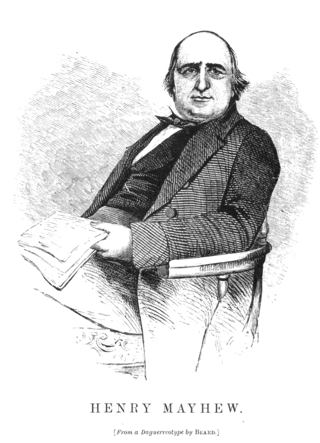
Henry Mayhew was an English journalist, playwright, and advocate of reform. He was one of the co-founders of the satirical magazine Punch in 1841, and was the magazine's joint editor, with Mark Lemon, in its early days. He is also known for his work as a social researcher, publishing an extensive series of newspaper articles in the Morning Chronicle that was later compiled into the book series London Labour and the London Poor (1851), a groundbreaking and influential survey of the city's poor.
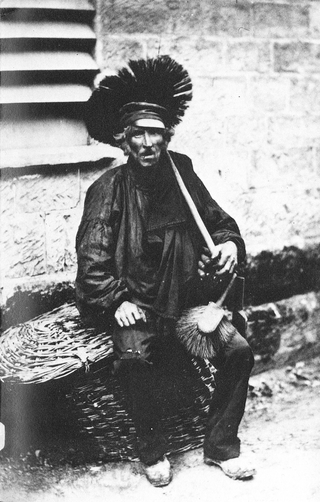
A chimney sweep is a person who clears soot and creosote from chimneys. The chimney uses the pressure difference caused by a hot column of gas to create a draught and draw air over the hot coals or wood enabling continued combustion. Chimneys may be straight or contain many changes of direction. During normal operation, a layer of creosote builds up on the inside of the chimney, restricting the flow. The creosote can also catch fire, setting the chimney alight. The chimney must be swept to remove the soot.

Bleak House is a novel by Charles Dickens, first published as a 20-episode serial between March 1852 and September 1853. The novel has many characters and several subplots, and is told partly by the novel's heroine, Esther Summerson and partly by an omniscient narrator. At the centre of Bleak House is a long-running legal case in the Court of Chancery, Jarndyce and Jarndyce, which comes about because a testator has written several conflicting wills. In a preface to the 1853 first edition, Dickens said there were many actual precedents for his fictional case. One such was probably Thellusson v Woodford, in which a will read in 1797 was contested and not determined until 1859. Though many in the legal profession criticised Dickens's satire as exaggerated, Bleak House helped support a judicial reform movement that culminated in the enactment of legal reform in the 1870s.

William Powell Frith was an English painter specialising in genre subjects and panoramic narrative works of life in the Victorian era. He was elected to the Royal Academy in 1853, presenting The Sleeping Model as his Diploma work. He has been described as the "greatest British painter of the social scene since Hogarth".

A costermonger, coster, or costard is a street seller of fruit and vegetables in British towns. The term is derived from the words costard and monger (seller), and later came to be used to describe hawkers in general. Some historians have pointed out that a hierarchy existed within the costermonger class and that while costermongers sold from a handcart or animal-drawn cart, mere hawkers carried their wares in a basket.
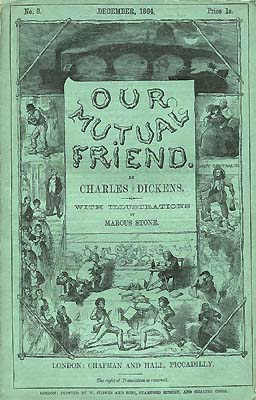
Our Mutual Friend, written in 1864–1865, is the last novel completed by Charles Dickens and is one of his most sophisticated works, combining savage satire with social analysis. It centres on, in the words of critic J. Hillis Miller, quoting the book's character Bella Wilfer, "money, money, money, and what money can make of life".

A street sweeper or street cleaner may refer to a person's occupation or to a machine that cleans streets.

A hawker is a vendor of merchandise that can be easily transported; the term is roughly synonymous with costermonger or peddler. In most places where the term is used, a hawker sells inexpensive goods, handicrafts, or food items. Whether stationary or mobile, hawkers often advertise by loud street cries or chants, and conduct banter with customers, to attract attention and enhance sales.
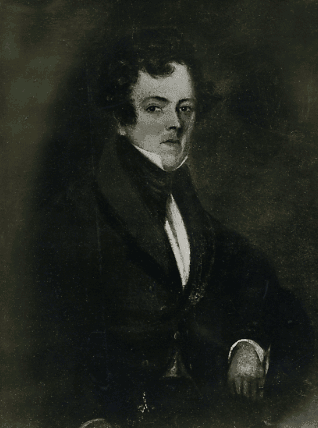
John Dickens was the father of famous English novelist Charles Dickens and was the model for Mr Micawber in his son's semi-autobiographical novel David Copperfield.
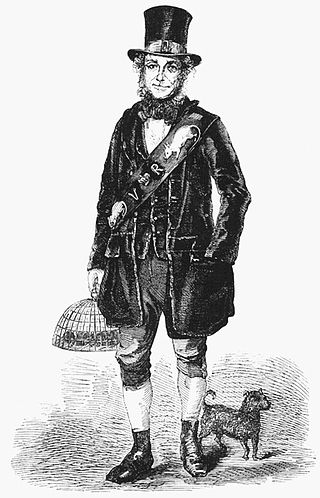
London Labour and the London Poor is a work of Victorian journalism by Henry Mayhew. In the 1840s, he observed, documented and described the state of working people in London for a series of articles in a newspaper, the Morning Chronicle, which were later compiled into book form.

Jacob's Island was a notorious slum in Bermondsey, London, in the 19th century. It was located on the south bank of the River Thames, approximately delineated by the modern streets of Mill Street, Bermondsey Wall West, George Row and Wolseley Street. Jacob's Island developed a reputation as one of the worst slums in London, and was popularised by the Charles Dickens novel Oliver Twist, published shortly before the area was cleared in the 1860s.
A rookery, in the colloquial English of the 18th and 19th centuries, was a city slum occupied by poor people and frequently also by criminals and prostitutes. Such areas were overcrowded, with low-quality housing and little or no sanitation. Local industry such as coal plants and gasholders polluted the rookery air. Poorly constructed dwellings, built with multiple stories and often crammed into any area of open ground, created densely-populated areas of gloomy, narrow streets and alleyways. By many, these parts of the city were sometimes deemed "uninhabitable".
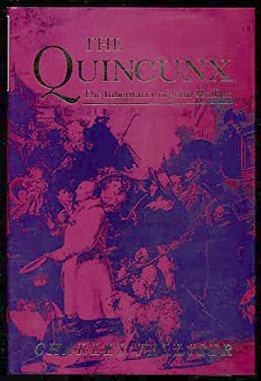
The Quincunx (The Inheritance of John Huffam) is the epic first novel of Charles Palliser. It takes the form of a Dickensian mystery set in early 19th century England, but Palliser has added the modern attributes of an ambiguous plot and unreliable narrators. Many of the puzzles that are apparently solved in the story have an alternative solution in the subtext.
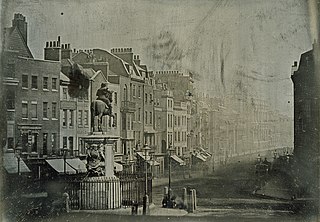
During the 19th century, London grew enormously to become a global city of immense importance. It was the largest city in the world from about 1825, the world's largest port, and the heart of international finance and trade. Railways connecting London to the rest of Britain, as well as the London Underground, were built, as were roads, a modern sewer system and many famous sites.

The Crossing Sweeper is an 1858 painting by William Powell Frith which has been described as breaking "new ground in its description of the collision of wealth and poverty on a London street." Frith later painted several versions of the same subject, updating the fashions.

The Death of Poor Joe is a 1901 British short silent drama film, directed by George Albert Smith, which features the director's wife Laura Bayley as Joe, a child street-sweeper who dies of disease on the street in the arms of a policeman. The film, which went on release in March 1901, takes its name from a famous photograph posed by Oscar Rejlander after an episode in Charles Dickens' 1853 novel Bleak House, and is the oldest known surviving film featuring a Dickens character. The film was discovered in 2012 by British Film Institute curator Bryony Dixon, after it was believed to have been lost since 1954. Until the discovery, the previous oldest known Dickens film was Scrooge, or, Marley's Ghost, released in November 1901.

Capital (ISBN 9780571234622) is a novel by John Lanchester, published by Faber and Faber in 2012. The novel is set in London prior to and during the 2008 financial crisis, jumping between December 2007, April 2008, and August 2008. The title refers both to London as the capital city of the United Kingdom, and to financial capital. All of the main characters have a connection to Pepys Road, a street in the south London suburb of Clapham.

Jennie Lee was a Victorian Era English stage actress, singer and dancer whose career was largely entwined with the title role in Jo, a melodrama her husband, John Pringle Burnett, wove around a relatively minor character from the Charles Dickens novel, Bleak House. She made her stage debut in London at an early age and found success in New York and San Francisco not long afterwards. Lee may have first starred in Jo around 1874 during her tenure at San Francisco's California Theatre, but her real success came with the play's London debut on 22 February 1876 at the Globe Theatre in Newcastle Street. Jo ran for many months at the Globe and other London venues before embarking for several seasons on tours of the British Isles, a return to North America, tours of Australia and New Zealand and later revivals in Britain. Reduced circumstances over her final years forced Lee to seek assistance from an actor's pension fund subsidised in part by proceeds from Royal Command Performances.

Dickensian is a British drama television series that premiered on BBC One from 26 December 2015 to 21 February 2016. The 20-part series, created and co-written by Tony Jordan, brings characters from many Charles Dickens novels together in one Victorian London neighbourhood, as Inspector Bucket investigates the murder of Ebenezer Scrooge's partner Jacob Marley.





















